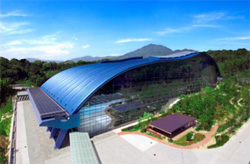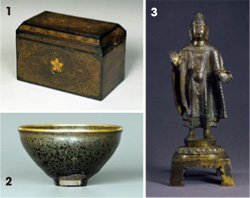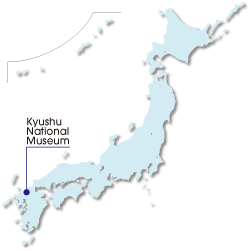Home > Highlighting JAPAN > Highlighting Japan JANUARY 2012 > The Kyushu National Museum
Highlighting JAPAN
THE NATION'S MUSEUMS
The Kyushu National Museum
Julian Ryall heads southwest to visit Japan's first new (2005) national museum for more than 100 years, and learns through a stunning range of exhibits how Asian cultures influenced the development of Japan.

Constructed from glass and wood, Kyushu National Museum blends into the surrounding hills.
And while its exhibits look back through the centuries, the museum's remarkable five-storey building is thoroughly modern and uses all the latest technologies to protect the items with which it has been entrusted.
"This area is very important for the understanding of all Japanese history because we have so many archeological sites," says Yoshihiko Akashi, an archeologist and director of the museum's Exhibition Division.
Standing above a large aerial photograph that encompasses Dazaifu, the city of Fukuoka to the north and the broad sweep of Hakata Bay beyond, Akashi points out key sites that date back as much as 1,350 years and can still be clearly seen to this day. They include the mizuki, or water fortress, a wall-and-moat defensive feature that was 14 meters high and 1.2 km long constructed across the valley below the key town of Dazaifu in 664.
The museum's main exhibition hall displays some 800 items of cultural and historical importance, with every single piece a genuine work, Akashi says.
"These are not only items that tell us about Japanese history, or that of the Kyushu region, but they are the history of Asian cultural exchanges," Akashi continues. "We want to explore the way in which Japanese culture has created its own uniqueness, in part by amassing and digesting foreign cultures."
The entrance to the museum is an impressive atrium-like hall with an elegantly curved roof. As well as an auditorium, the first floor includes Ajippa Square—which takes its name from Ajia-noharappa, meaning Asian fields, where children and adults alike are encouraged to handle everyday items from across east Asia, from Malaysian puppets to Okinawan musical instruments, Indonesian face masks, kites from the Himalayan kingdoms and national costumes.
The fourth floor is given over to the Main Exhibition Hall and takes as its theme "Ocean Ways, Asian Paths" for the five sections. The hall is ingeniously designed to enable the curators to move and change the exhibits at regular intervals, while the subtle lighting shows off the items to their full glory.
Visitors are initially taken into the prehistoric Jomon period (13,000 BCE–300 BCE) and are treated to a video depicting the lives of the first hunter-gatherers who inhabited what is modern-day Kyushu. It also shows the devastating eruption of Mount Aso 90,000 years ago, a blast that left much of Kyushu covered in several meters of debris from the volcano.
In nearby display cases, 35,000-year-old cutting tools are made of stones that were originally from the Korean peninsula, Siberia and other parts of mainland Asia, indicating just how far back this region's trading ties extend.
The next section is devoted to the arrival of rice-growing culture and includes remarkably well-preserved wooden tools from the Yayoi period (300 BCE–300 CE). There is also a recreation of the large jar used for royal burials in the Yayoi period, complete with mirrors imported from China and a spear, based on the first-century tomb excavated at Itoshima, Fukuoka Prefecture.
The third section of the museum examines the age of the envoys, when trade and political ties were forged with dynasties on mainland Asia, including along the length of the Silk Road, which brought metalwork items and glass from the Middle East.
The exhibits include part of a Mongol ship that was part of the invasion fleet destroyed by the "divine wind" in 1281, a fourteenth-century sword by master-swordsmith Rai Kunimitsu and a horde of 100,000 copper coins that were found buried in a large earthenware jar and whose owner had never returned to collect them.
Important Cultural Properties on display at the Kyushu National Museum
 1. Buddhist scriptures box with peacock design gold lacquerwork, from Yuan-Dynasty China (1315). Chinese lacquerwork became popular in Japan from around this point on, in the Muromachi period (1336–1573). 2. Yutekitenmoku bowl from Kenyo, southern China, thirteenth century. Yutekitenmoku ware takes its name from the patterns which look like scattered oil on the surface. This piece, measuring 12.6 cm across and 7 cm tall, is a particularly beautiful example. 3. Bronze Buddhist statue, from North Wei-Dynasty China (443). Standing 53.5 cm tall, the figure has a strong muscular body and curly hair, indicating influence from the west. |
| Access and Admission |  |
|
| Address: | The Kyushu National Museum 4-7-2 Ishizaka, Dazaifu City, Fukuoka Prefecture 818-0118. | |
| Tel/Fax: | +81 (0)92 918 2807/+81 (0)92 918 2810. | |
| Website: | www.kyuhaku.jp | |
| Opening Hours: | 9:30 a.m. to 5 p.m. (last admission at 4:30 p.m.). Closed on Mondays and New Year Holidays. If a Monday is a national holiday, the museum will be closed the following day. | |
| Tickets: | 420 yen for adults and 130 yen for college students. Free for children below the age of seventeen and those aged seventy or older. | |
© 2009 Cabinet Office, Government of Japan






